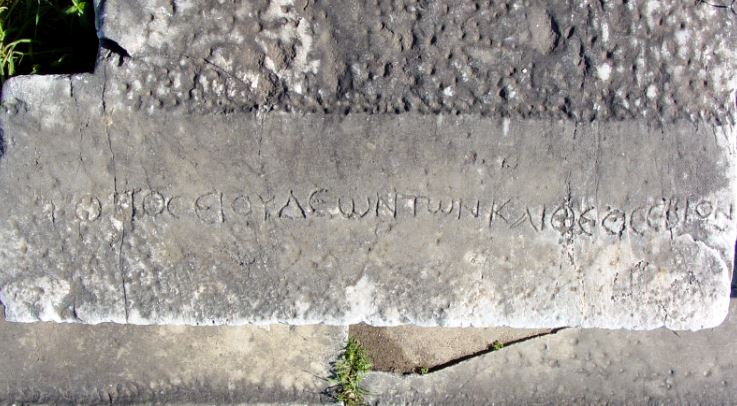Discover Ephesus and Top Destinations in Western Turkey with an expert tour guide and a TripAdvisor Winner for 13 consecutive years.
History of Ancient Miletus and Didyma - Private Miletus Didyma ToursMiletus, in the archaic period known as the ruler of the Aegean, birthplace of science and philosophy. Owed its importance to its position on trade routes and developed seamanship. According to Homer Miletus was the exceptional Ionian city that fought against the Greeks with the Trojans. Miletus is one of the 12 ionian cities located in Western Turkey. Visited by Saint Paul and mentioned in Acts Chapter 20. Miletus was located by the river Meandros where English word meandering also originated from. The length of the Meandros River is 550 km. Sourced from Denizli Province and has been silting up the bay where Miletus and Priene cities are located. First settlement dates back to 1600 BC by Minoans and Mycenaeans. According to the legend, the city was founded by Neleus, son of King Codrus of Athens. The residents were Carians and Cretans who moved here from a city having the same name. Neleus came to settle with his men and killed the resident males, forcing the women to marry the newcomers. After this took place the women swore not to sit at the same table with their husbands and also not to call them by their names and this became a tradition for the next generations. The city is also mentioned in the Hittite inscriptions as Milawanda. In the 11th century BC Ionians came to Miletus, and by 7th century BC Miletus was at its peak which was to last for more than two centuries. Miletus colonized over 90 cities such as Sinope, Amissos, Trapezos... located at the Black Sea shores of Anatolia. With other cities of Ionia in 499 BC, Miletus rebelled against the Persians, who had captured, burned it to the ground and enslaved its surviving population. This last battle was that of Lade (Island of Lade) in 494 BC, just outside the harbor of Miletus where the Persian fleet of 600 warships defeated the Ionian force. The role of Miletus was significant in the defeat of the Persians at the Mycale battle in 479 BC. Shortly after the battle, Miletus joined the Delian Confederacy with a contribution larger than that of Ephesus. Miletus joined this alliance with 80 ships while Priene was joined with 12 ships. Upon an agreement between the Persian Satrap and Athens, Miletus and other Ionian cities of Anatolia came under the rule of the Persians again. At the end of the 5the century BC Miletus, was ruled by the Carian satraps. Captured by Alexander the Great after a siege in 334 BC. Miletus were among the cities who fought with Persians against Alexander's Army and defended their land. After being ruled by the Seleucid Dynasty in the following years, Miletus remained an important trade center in Roman times. In the Hellenistic period, Miletus was one of the largest cities in Anatolia with a population of between 80,000 and 100,000. Highly prosperous, it founded many colonies and was the home of the 6th century BC philosophers Anaximander, Anaximenes, and Thales, the town planner Hippodamus and architect Isidorus. Miletus seems to have produced geniuses the way Aphrodisias produced sculptors. Anaximander known as the father of geography by drawing the first map of the world. Thales was the most important among them. He was considered to be one of the 7 geniuses of the Ancient World as well as Bias of Priene and Solon of Athens. In 585 BC by calculating the solar eclipse, he became very famous. He believed that the source of life and living creations is out of water. He also calculated the height of the pyramids. Furthermore, he managed this by checking up with help of the length of a person's shadow. In the day time when a person's shadow was equal to his height, he made the calculations with the Pyramids. How far is Miletus from Ephesus?Miletus is 50 miles away from Ephesus. After the riot took place in the theater of Ephesus. St, Paul was kicked out from the city of Ephesus. He traveled north to Troas, Assos, Mitylene. Chios. Samos, St. Paul stopped in Miletus in 57 AD on his way back to Jerusalem at the end of his third missionary journey. In Miletus Paul sent a message to the leaders of the church in Ephesus to join him in Miletus, and after speaking with them for the last time he bade them an emotional farewell. Paul warned them that he faces persecution and imprisonment when he returns to Jerusalem. Paul boarded his ship in Miletus and sailed off via Cos, Rhodes, Patara to Jerusalem. The Roman period was followed by Byzantine and Turkish periods. Miletus was a major port city located on a peninsula with four harbors. With the silting of the Meander River the ruins of the ancient city today are a few kilometers away from the sea. The city had a grid plan which was developed by Hippodamus when it was rebuilt in the 3rd century BC after the Persians had sacked it. The Theater was a small Hellenistic theater with a seating capacity of 5,300, but in the beginning of the 2nd century AD it was modified to a Roman theater and held about 15,000 people. The lower section was built onto a natural hillside, and the upper is supported by vaulted substructures up to a height of 131 ft. The facade facing the harbor was 460 ft long. During the Roman period the stage building had three stories and was 111 ft wide. In front of the stage building it is still possible to see pieces depicting gladiators fighting against wild animals. From the 3rd row till the 6th, carvings show that some seats were reserved for some persons and groups. The 5th row was reserved for the Jews and Theosebes (God-fearers) who are afraid of God and the 3rd row for the Jewelers. The Theosebes were Jewish sympathizing pagans with beliefs and rituals of their own. The Theosebes were one of the key groups that received the attention of St. Paul and his mission. At the top of the theater hill was a Byzantine fortress which is thought to have been built mostly with the stones of the theater in the 7th century AD but restored later by a Turkish tribe called Mentese Ogullari. Harbor monuments stood in front of the Lions’ Harbor. There were two of them; different in size but similar in style. The large piece was 25 ft high, mounted on a three-cornered base built on a round foundation with a diameter of 36 ft. The smaller one was only 17.5 ft. The Delphinium was a Hellenistic open air shrine surrounded by stoas on four sides with a 6th century BC altar in the center. Together with Apollo, the dolphin was sacred for the Milesians as they believed that when the first settlers sailed they were guided by Apollo in the form of a dolphin. The annual festival and celebrations of Didyma were started here. An Ionic Stoa lay parallel to the processional road on the south of the Delphinium. It is a 1st century AD structure which had 35 Ionic columns and 19 shops behind the columns. Delphinios name meaning Dolphin in Greek is also correlated with Delphoi of Greece. According to the legend, Apollo, who needed priests for his temple, saw a Cretan ship at the horizon. He turned himself into a dolphin and led the seamen where the temple was located. The Bouleterion was a 2nd century BC building which consisted of a pro pylon, a courtyard and an auditorium. The pro pylon had three Corinthian columns and friezes depicting war scenes. It opened into a courtyard with a monumental tomb in the middle. There were four gates that opened into the main hall. The auditorium seated 1,500 people and had a wooden roof. The Nymphaeum was first built in the 2nd century AD and rebuilt in the following century. It faced the bouleuterion across the processional road and had three stories with statues of gods placed in niches and water spouting from the mouths of bronze fish. The South Agora lay behind the bouleuterion. It was a Hellenistic structure which was later remodeled in the Roman period. Today the North Gate is unfortunately another of the gems from Anatolia currently housed in the Pergamon Museum in Berlin. The South Gate was destroyed during the construction of Ilyas Bey mosque. The Temple of Serapis lay between the south Agora and the Faustina baths. It consisted of a pronaos and a naos with Corinthian columns and a relief of Serapis on the pediment. The temple was a 3rd century BC building which was rebuilt in the 3rd century AD with a donation by Emperor Marcus Aurelius. The Baths of Faustina were 2nd century AD Roman baths which were built by Faustina, Marcus Aurelius’ wife, daughter of Antonius Pius who usually accompanied her husband on his journeys through the Empire. Faustina was famous for wasting the Roman treasury. The frigidarium had a reclining statue of the river god probably personifying the Meander River. The baths are a complex structure with Gymnasium and Stadium located next to it. Caldarium was heated by hypocaust system underground heating was practiced. Ground was over 2 feet high legs. The hot air was going through which was gathered by boiling water in the furnaces. The Ilyas Bey Mosque was part of a complex which consisted of a mosque, medrese, cemetery and an imaret. It was built in the early 15th century by Ilyas Bey, the regional Ottoman military commander. The dome of the mosque was made of bricks. At the entrance are three arched partitions separated by two columns. The entrance is through the center arch. The mosque was destroyed in 1955. The Caravansary is a 15th century building built by the Mentese Principality which had a lower floor for animals and an upper for people. The Apollo Temple in DidymaThe word Didyma meant "twins' ' and was associated by some as being the meeting place of Zeus and Leto to have their twins Apollo and Artemis. Didyma was famed as a prophecy center dedicated to Apollo which served a similar purpose as the Delphi of Anatolia. It was not a city but a sanctuary linked to Miletus by Milesians with a 12 miles sacred road. However, this road was constructed at the end of the 1st century AD during the reign of Trajan. Before his reign citizens of Miletus used to sail to Panormos and then walk to the temple. In addition to pilgrimages made by sea, some festivals of drama, music and sports were held there every four years. Even though it is thought that there was a shrine there before the Ionians came in the 10th century BC, a temple at the same site was built in the 6th century BC. According to the legend, it was founded and ruled many years by a noble family called Brankhidai who migrated here from Delphoi. Later destroyed by the Persians in 494 BC. In the 4the century BC Milesians started to rebuild the temple but could not complete it because of financial difficulties. When Alexander was in Didyma, it is prophesied that Alexander is the son of Zeus and will have a victory in Gaugamela. In the 1st and 4th centuries AD Roman emperors tried but could not complete the construction either. Later in the Byzantine period Theodosius II had a church built in the open air courtyard which was destroyed by an earthquake in the 15C AD. Jesus' identity whether he is a god or a human was also consulted at Apollon temple. The answer was "he was a human when he was alive''. Among the people who were consulting there were villagers as well as kings and commanders. Even in its unfinished state the Apollo Temple was regarded as one of the largest temples of the Hellenistic world, comparable to the Artemis Temple in Ephesus or the Heraion at Samos. The temple was 360 ft long and 167 ft wide with a height of 78 ft. It is a dipteros in Ionic order with 120 columns 108 of them surrounding the building by a double row and 12 in the pronaos. Because of its gigantic size, it never had a roof. As George Bean points out in Aegean Turkey, the Apollo Temple "serves as a reminder that vastness in architecture was not purely a monopoly of the Romans''. It was an unusual temple, not only because of its huge size but also for its antechamber with two Corinthian columns and two tunnels that led into the cellar. The antechamber which was also termed as Cresmographeion probably served as an oracle office where prophecies were written out and delivered to people. In the middle of the temple there is an open air courtyard (adyton) with another Ionic shrine which housed the cult statue of Apollo. There were a few hot springs where the priestess of Didyma immersed her feet or inhaled the water’s vapors for inspiration before prophesying. The huge Medusa relief standing next to the temple is a 2nd century AD piece which has fallen off the frieze. A little further stand the remains of an altar and a well. Before asking for a prophecy from the priests in the pronaos, people purified themselves with water from the well and gave votive offerings in the altar. They were not allowed to go near the head nun Phytia. Priests called Hexametron were putting the verbal explanations of Phytia into words. The sacred water and the vapor was the source of prophecy. Hexametrons were considered to be the highest rank officers in the city of Miletus. They were elected and had to live in Didyma during their service period. Next to Apollon temple there was a temple dedicated to Artemis and a stadium. The steps of the temple were used as seats to the stadium. Names for the reserved seats can still be noted. We offer private tours of Miletus and Didyma. In these private tours, besides Miletus we also stop at Ancient City of Priene or Domatia (Doganbey) Village. For more information, please contact us.
0 Comments
Leave a Reply. |
Ephesus Travel Guideby TransBalkan Tours is a fully licenced tour operator since 1963 and a member of TURSAB. Ephesus Tour from Kusadasi Port
Ephesus Tour from Izmir Ephesus Tour from Selcuk Ephesus Tour Guide Kusadasi Airport Transfer Kusadasi Pamukkale Tour Ephesus Biblical Tour Istanbul Ephesus Tour Ephesus Guided Tour Ephesus Shore Excursions Efes Tur Rehberi Ephesus Walking Tour 7 Churches Tour Turkey Categories
All
Archives
July 2024
|









 RSS Feed
RSS Feed
